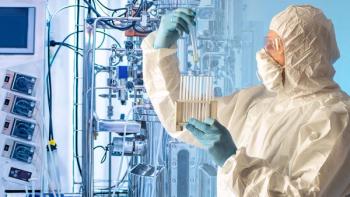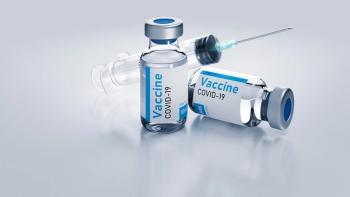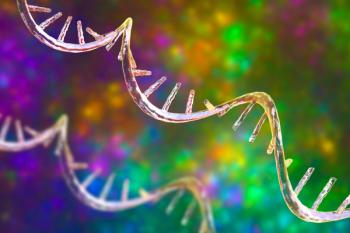
- BioPharm International-03-02-2008
- Volume 2008 Supplement
- Issue 3
Process-Scale Precipitation of Impurities in Mammalian Cell Culture Broth
If certain engineering challenges can be addressed, precipitation may prove to be a valuable tool for antibody purification.
ABSTRACT
Alternatives to standard chromatography for the purification of MAbs have been analyzed at the industrial scale. This article discusses an alternative use of precipitation to remove cell culture broth impurities, including DNA and host cell protein, while leaving the antibody in the supernatant. It evaluates several types of precipitation agents that are suitable for use in the manufacture of a parenteral therapeutic agent. The applications of this technology at scale are also discussed.
Many current research initiatives are focused on finding alternatives to column chromatography for the purification of monoclonal antibodies (MAbs). The industry-standard capture resin, Protein A, is expensive, has relatively low capacity compared to ion exchange (IEX) resins, and does not tolerate cleaning agents, which limits the resin lifecycle. Attempts to develop alternative capture resins have met with some success, but they generally do not offer the same platform potential as Protein A. An initial purification step with the purification capability and generic nature of Protein A is required, but at lower cost and increased capacity.
In their recent review, Przybycien and colleagues discuss how other industrial applications have used processes without chromatography for years because of the uniqueness of the target molecule.1 The paper classifies the alternative technologies into three distinct areas—bulk, field-based, and adsorptive separation—which are categorized according to their industrial maturity versus resolution potential. Precipitation is described as a mature technology with low resolution potential. However, MAbs have unique properties compared to other components of the broth, which could result in more selective precipitation.
This article will discuss an alternative use of precipitation to remove cell culture broth impurities, including DNA and host cell protein (HCP), while leaving the antibody in the supernatant. It will also present the results of recent experiments determining the efficacy of potential precipitants in impurity removal, and discuss the applications of this technology at scale.
Precipitation of DNA and Protein—Other Applications
A comprehensive search of the literature reveals that precipitants have been used extensively in other industrial applications, and some of these could potentially be adapted for MAb purification. The precipitants fall into two categories—those used to purify DNA and proteins, and those used as a precipitating agent to purify antibodies, which could be optimized to remove impurities while leaving the antibody in the solution.
Several precipitants described in the literature are used to purify DNA in aqueous solutions. These include, but are not limited to, indium chloride, polyaluminum chloride, manganese chloride, and zinc.2–5 In addition, several groups have reported on the use of polyamines, such as spermine and spermidine, for DNA precipitation.6,7 While these techniques are appropriate for precipitation at the laboratory scale as research techniques, they are not suitable for various reasons for industrial-scale manufacture.
There are, however, precipitants referenced in the literature that could be adapted for use in therapeutic MAb manufacture. One such class of compounds is charged polymers, such as polyethyl-eneimine (PEI) and polyacrylic acid (PAA), which have proven effective in precipitating both proteins and nucleic acids because of the interaction between the charges on the proteins and the polymers, creating an insoluble complex.8 The use of PEI for the precipitation of nucleic acids has been studied in detail by Cordes and colleagues and by Dissing and Mattiason.9,10
In addition to charged polymers, cationic detergents such as cetyltrimethyl ammonium bromide (CTAB) and domiphen bromide (DB) have been used to precipitate cellular DNA.11,12 Goerke and colleagues were able to demonstrate the use of DB as a DNA precipitant in the purification of adenovirus.12
Persson, et al., used 6,9-diamino-2-ethoxyacridine lactate (ethacridine or ethodin) as a precipitant for both DNA and HCP from an Escherichia coli homogenate containing antibody fragments.13 The use of ethacridine (a highly aromatic, cationic dye used as an antiseptic) as a precipitant in antibody purification was first demonstrated by Horejsi and colleagues in 1956.14
Of particular interest are the numerous descriptions of the use of short-chain fatty acids, such as caprylic acid, for the precipitation of plasma proteins and DNA, as first described by Chanutin and Curnish in 1960.15 Several groups have developed conditions for the use of caprylic acid in antibody purification from various starting materials, such as ascites fluid and mammalian serum.16–19 Parkinnen and Lundblad also showed that caprylic acid could inactivate enveloped viruses.20,21
Evaluating Potential Precipitants for Impurity Removal
Protocol
Using this large body of work as a guide, the Mammalian BioProcess Research and Development group at Pfizer, Inc. (New York, NY), recently completed an evaluation of several chemical compounds that could potentially be used to precipitate impurities from mammalian cell culture broth containing a MAb. Various cell culture broths from either Chinese hamster ovary (CHO) or NS0 cell lines were grown in an instrumented bioreactor from 1–10 liters in size. The chemical compounds discussed in this article are listed in Table 1.
Table 1. Characteristics of the chemical compounds used in the precipitation evaluation
The basic experimental protocol used for the evaluation was as follows: Cells and cellular debris were removed by centrifugation and depth filtration before the study commenced. The broth was adjusted to a final concentration of approximately 1 g antibody/L solution, the pH was adjusted, and the potential precipitant was added. The broth was incubated for 30–60 min, then pelleted in a Sorvall Evolution RC centrifuge for 10 min at 4,000g. The supernatant was separated from any precipitate, and if possible the precipitate was resolubilized. The resulting fractions of clarified supernatant and resolubilized precipitate were then tested for impurity levels using a standard Cygnus kit (Cygnus Technologies, Southport, NC) for HCP and the threshold assay for DNA. All of the precipitating agents were obtained from Sigma-Aldrich Chemical Co. (St. Louis, MO).
Ammonium Sulfate Precipitation
Ammonium sulfate precipitation for the purification of MAbs has been extensively documented in the literature.22–24 This method was performed and used as a standard comparison for antibody purity. In this case, the antibody was precipitated while the impurities remained in solution. After evaluating a range of ammonium sulfate concentrations, 1.8–2.0 M was chosen and tested for impurity removal and product yield at various pH values ranging from 4.0–7.0. The resulting precipitate was recovered by centrifugation and washed three times with ammonium sulfate solution to remove additional impurities. The precipitate was then resolubilized and analyzed.
The best results obtained using a variety of NS0- and CHO-produced antibodies are shown graphically in Figure 1. The results indicate a 21-fold reduction in HCP (to 8,960 ng HCP/mg antibody) from the starting broth value, and a 79-fold reduction in DNA (to 38,800 pg DNA/mg antibody) with a yield of 91%. The fold reduction in impurities was calculated by dividing the impurity value in the broth by the impurity value in the antibody phase (supernatant or resolubilized precipitate, as appropriate).
Figure 1. Best results obtained from ammonium sulfate precipitation using a variety of NS0- and CHO-produced antibodies.
Cationic Detergents
Both CTAB and DB were tested extensively, initially using only the NS0-derived antibody. Although neither compound reduced the amount of HCP, both were effective in the precipitation of DNA. The best results obtained with CTAB (5 mM) were a 164,000-fold reduction in DNA levels, down to ~190 pg DNA/mg antibody, which is significantly better than that obtained with the ammonium sulfate standard.
DB (5 mM) performed even better than CTAB, reducing DNA to undetectable levels at all pH values tested, with very high recovery of MAb in the supernatant (>95%). Additional experiments were performed on a CHO-produced antibody and the results are summarized in Figure 2. There was no significant reduction in HCP levels, but DNA levels were below the level of detection for the assay (note that HCP levels are shown as a fold reduction, whereas DNA levels are actual values). For all of the DB concentrations and pH values tested, the starting value was >11 x 106 pg DNA/ mg antibody, showing that DB is very effective at precipitating DNA while leaving the antibody product in solution.
Figure 2. Best results obtained from domiphen bromide precipitation of impurities in CHO-produced monoclonal antibody cell culture broth
Caprylic Acid Precipitation
Initial experiments were performed using an NS0-produced antibody at low pH values (3.4–4.8) and a caprylic acid concentration of 30 mM, based on information from the literature. Although there was no reduction in HCP levels, DNA levels were undetectable at the higher pH values tested. Additional testing for both NS0- and CHO-produced antibodies at pH 4.0–6.0 and caprylic acid concentrations of up to 100 mM confirmed that, for the NS0-produced antibody, DNA was significantly reduced at the lower pH values while HCP was not affected. However, for the CHO-produced antibody, both HCP and DNA were significantly reduced at all pH values tested.
Additional experiments confirmed that although DNA values were reduced below the level of detection for both NS0- and CHO-produced antibodies, the impact of caprylic acid on HCP levels differed significantly according to the cell line (Figure 3). For the CHO-produced antibody, the reduction in HCP levels continued to increase in line with the caprylic acid concentration. However, for the NS0-produced antibody, there were no further significant improvements in HCP clearance at caprylic acid concentrations above 100 mM. The yield for the CHO-produced samples averaged 92%, and caprylic acid precipitation performed at pH 6.0 with 500 mM caprylic acid resulted in the best overall performance (650-fold reduction in HCP to 160 ng/mg antibody, and 6,475-fold reduction in DNA to 700 pg/mg antibody. These results were significantly better than those obtained using ammonium sulfate precipitation.
Figure 3. HCP fold reduction values for caprylic acid precipitation using both a CHO- and NS0-produced antibody
Industrial-Scale Precipitation
Given the results discussed above, how could such a process be scaled, what technologies could be used, and where might it fit in a standard MAb purification scheme? If the goal is to remove the majority of the impurities before the initial chromatography step, then it must be located at the harvest step, where two major technologies, centrifugation or filtration, could be used (Figure 4).
Figure 4. Potential purification schemes using a precipitation step
The type of centrifugation most commonly used in MAb processes is disc-stack centrifugation, which is ideal for separation when the solids concentration is low, or where smaller particles are present.25 This technology and its adaptation to mammalian cell culture broth has been described extensively in the literature and presented at conferences.26–29 For developing a centrifugation step to remove the precipitate, a scale-down model would need to be developed.30,31 Once this model was available, the parameters affecting separation could be studied and optimized. For centrifugation, such parameters would include the sigma factor, the relative densities of the materials to be separated, angular velocity, viscosity, feed flow rate, and temperature.32 In addition, solids removal from the bowl during continuous flow centrifugation could also play an important role in centrate quality.33
The other option is depth filtration, which is also used extensively to process MAbs and related molecules.34,35 Depth filtration has advantages over centrifugation such as the removal of DNA and HCP.36,37 However, it is no trivial matter to screen the wide array of depth filters currently available and determine the correct one for the application, and then determine the optimal parameters for processing, which include the pH and ionic strength of the feed fluid, feed flux, membrane area, and operating pressure.38
If a technique can be adapted for precipitate removal following treatment with an agent such as caprylic acid, the technology could be very useful. Early removal of significant amounts of HCP and DNA could result in the adaptation of a shorter purification process or better performance and longer life of the capture resin.
Summary
Alternatives to standard chromatography for the purification of MAbs have been discussed in detail in the literature. One such alternative, precipitation, is used extensively in other applications for the purification of polysaccharides, DNA, and viruses, and may be adaptable to antibody purification. The technology could be manipulated to precipitate out the antibody, as is the case with ammonium sulfate, or to reduce impurity levels while leaving the antibody in solution.
Several potential precipitating agents that have been used in other applications were evaluated for their ability to purify antibodies by reducing HCP and DNA. Two cationic detergents, CTAB and DB, were able to precipitate DNA much more effectively than ammonium sulfate. In addition, the short-chain fatty acid caprylic acid was able to remove both DNA and HCP very efficiently for CHO-produced antibodies, but less efficiently for NS0-produced antibodies. A precipitation step targeting the removal of impurities could be developed using centrifugation or depth filtration technology during the harvest operation, but would need to be optimized to ensure the cost of goods compared favorably with a standard chromatographic technique such as Protein A. If these engineering challenges can be addressed, precipitation may prove to be a valuable tool for antibody purification.
Acknowledgements
I wish to thank Tara Carter for her excellent experimental capabilities that made this work possible, and to Paul Mensah for his guidance and advice.
This is an excerpt from the chapter in the forthcoming John Wiley and Sons book Process Scale Purification of Antibodies edited by Uwe Gottschalk.
JUDY GLYNN is a senior principal scientist at Pfizer, Inc., Chesterfield, MO, 636.247.6519,
References
1. Przybycien T, Narahari S, Steele L. Alternative bioseparation operations: life beyond packed-bed chromatography. Current Opin Biotechnol. 2004;15:469–478.
2. Akcasu A, Akcasu M, Tumay S. A new method for the differential precipitation of nucleic acids from aqueous solutions. Nature. 1960;4734:23–324.
3. Matsuzawa Y, Hiraishi A. Study on DNA precipitation with a cationic polymer PAC (poly aluminum chloride). Nucleic Acids Res Supplement. 2003;3:163–164.
4. Christensen P, Danielczyk, A, Stahn R, Goletz S. Simple separation of DNA in antibody purification. Protein Expr Purif. 2004; 37:468–471.
5. Kejnovsky E, Kypr J. DNA extraction by zinc. Nucleic Acids Res. 1997;25(9):1870–1871.
6. Raspaud E, de la Cruz O, Sikorav JL, Livolant F. Precipitation of DNA by polyamines: a polyelectrolyte behavior. Biophys J. 1998;74:381–393.
7. Choe W, Middelberg A. Selective precipitation of DNA by spermine during the chemical extraction of insoluble cytoplasmic protein. Biotechnol Prog. 2001;17:1107–1113.
8. Clark K, Glatz C. Polymer dosage considerations in polyelectrolyte precipitation of protein. Biotechnol Prog. 1987;3(4):241–247.
9. Cordes R, Sims W, Glatz C. Precipitation of nucleic acids with poly(ethyleneimine). Biotechnol Prog. 1990;6:283–285.
10. Dissing U, Mattiasson B. Integrated removal of nucleic acids and recovery of LDH from homogenate of beef heart by affinity precipitation. Bioseparation. 1999;7:221–229.
11. Del Sal G, Manfioletti G, Schneider C. The CTAB-DNA precipitation method: a common mini-scale preparation of template DNA from phagemids, phages, or plasmids suitable for sequencing. BioTechniques. 1989;7(5):514–519.
12. Goerke A, To B, Lee A, Sagar S, Konz J. Develop of a novel adenovirus purification process utilizing selective precipitation of cellular DNA. Biotechnol Bioeng. 2005;91(1):12–21.
13. Persson J, Lester P. Purification of antibody and antibody-fragment from E. coli homogenate using 6,9-diamino-2-ethoxyacridine lactate as precipitation agent. Biotechnol Bioeng. 2004;87(3):424–434.
14. Horejsi J, Smetana R. The isolation of á-globulin from blood serum by Rivanol. Acta Medica Scand. 1956;155:65–70.
15. Chanutin A, Curnish R. The precipitation of plasma proteins by short-chain fatty acids. Arch Biochem Biophys. 1960;89:218–220.
16. Habeeb A, Francis R. Preparation of human immunoglobulin by caprylic acid precipitation. Prep Biochem. 1984;14(1):1–17.
17. McKinney M, Parkinson A. A simple, nonchromatographic procedure to purify immunoglobulins from serum and ascites fluid. J Immunol Methods. 1987;96:271–278.
18. Reik L, Maines S, Ryan D, Levin W, Bandiera S, Thomas P. A simple, nonchromatographic purification procedure for monoclonal antibodies. J Immunol Methods. 1987;100:123–130.
19. Temponi M, Kageshita T, Perosa F, Ono R, Okada H, Ferrone S. Purification of murine IgG monoclonal antibodies by precipitation with caprylic acid: comparison with other methods of purification. Hybridoma. 1989;8(1):85–95.
20. Parkkinen J, Rahola A, von Bonsdorff L, Tölö H, Törmä E. A modified caprylic acid method for manufacturing immunoglobulin G from human plasma with high yield and efficient virus clearance. Vox Sang. 2006;90:97–104.
21. Lundblad J, Seng R. Inactivation of Lipid-Enveloped Viruses in Proteins by Caprylate. Vox Sang. 1991;60:75–81.
22. Habeeb A, Francis R. Preparation of human immunoglobulin by ammonium sulfate precipitation. Vox Sang. 1976;31:423–434.
23. Kent U. Purification of antibodies using ammonium sulfate fractionation or gel fractionation. Methods in Molecular Biology, 115, Humana Press, Inc., Totowa, New Jersey. 1999;pp. 11–18.
24. Page M, Thorpe R. Purification of IgG by precipitation with sodium sulfate or ammonium sulfate. The Protein Protocols Handbook, 2nd Edition, Humana Press, Inc., Totowa, New Jersey. 2002;pp. 983–984.
25. Shenoy V, Kulkarni M. Centrifuges in the process industry. Chem Ind Digest. 2006;19(2):63–68.
26. Kempken R, Preissmann A, Berthold, W. Assessment of a disk stack centrifuge for use in mammalian cell separation. Biotechnol Bioeng. 1995;46:132–138.
27. Shpritzer R, Acharya H, Petrone J, Vicik S. Evaluation of a continuous disc stack centrifuge for the clarification of mammalian cell cultures. The 225th ACS National Meeting. New Orleans, LA. 2003;Mar 23–27.
28. Glynn J, Zaman F, Chen B, Wealand J, Mensah P. Development of a MAb harvest protocol. Biochemical Engineering XV: Engineering Biology from Biomolecules to Complex Systems. Quebec City, Canada. 2007;Jul 15–19
29. Raghunath B. Cacace B, Yavorsky D. Strategies for optimizing upstream clarification of cell culture fluids. The 234th ACS National Meeting, Boston, MA. 2007;Aug 19–23.
30. Maybury J, Mannweiler K, Titchener-Hooker N, Hoare M, Dunnill P. The performance of a scaled down industrial disc stack centrifuge with a reduced feed material requirement. Bioprocess Eng. 1998;18:191–199.
31. Hutchinson N, Bingham N, Murrell N, Farid S, Hoare M. Shear stress analysis of mammalian cell suspensions for prediction of industrial centrifugation and its verification. Biotechnol Bioeng. 2006;95(3):483–491.
32. Russell E, Wang A, Rathore A. Harvest of a therapeutic protein product from high cell density fermentation broths: principles and case study. Biotechnol and Bioprocess. 2007;31:1–58.
33. Duffy J, Mcnerny T, Wypych J. Centrifugation strategies for recovery of a mammalian expressed MAb. The 227th ACS National Meeting, Anaheim, CA. 2004;Mar 28–April1.
34. Bates R, Ma J, Mason C. Case study: optimization of harvest stream clarification steps of a commercially-relevant fusion protein mammalian cell culture using charged depth filters. The 234th ACS National Meeting, Boston, MA. 2007;Aug 19–23.
35. Prashad M, Tarrach K. Depth filtration: Cell clarification of bioreactor offloads. Filtration + Separation. 2006;43(7):28–30.
36. Charlton H, Relton J, Slater N. Characterization of a generic MAb harvesting system for adsorption of DNA by depth filters and various membranes. Bioseparation. 1999;8: 281–291.
37. Yigzaw Y, Piper R, Tran M, Shukla A. Exploitation of the adsorptive properties of depth filters for host cell protein removal during MAb purification. Biotechnol Progr. 2006;22:288–296.
38. Arnold T. Fluid purification using charge-modified depth filtration media. Bioprocess Int. 2005;3(10):44–49.
Articles in this issue
almost 18 years ago
Purification of IgM Monoclonal Antibodiesalmost 18 years ago
Economic Drivers and Trade-Offs in Antibody Purification Processesalmost 18 years ago
Solutions for Purification of Fc-fusion ProteinsNewsletter
Stay at the forefront of biopharmaceutical innovation—subscribe to BioPharm International for expert insights on drug development, manufacturing, compliance, and more.





